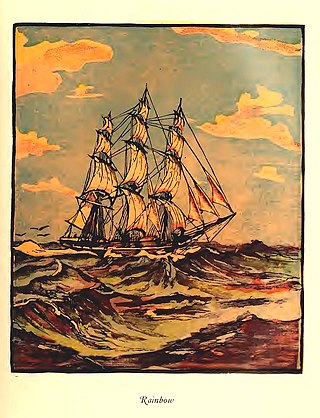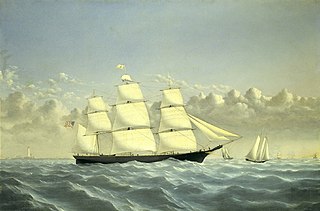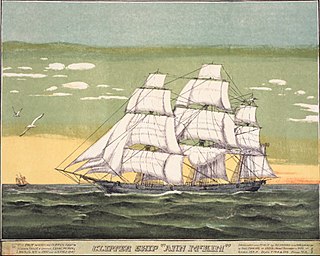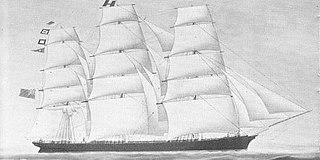
A clipper was a type of mid-19th-century merchant sailing vessel, designed for speed. Clippers were generally narrow for their length, small by later 19th-century standards, could carry limited bulk freight, and had a large total sail area. "Clipper" does not refer to a specific sailplan; clippers may be schooners, brigs, brigantines, etc., as well as full-rigged ships. Clippers were mostly constructed in British and American shipyards, although France, Brazil, the Netherlands, and other nations also produced some. Clippers sailed all over the world, primarily on the trade routes between the United Kingdom and China, in transatlantic trade, and on the New York-to-San Francisco route around Cape Horn during the California Gold Rush. Dutch clippers were built beginning in the 1850s for the tea trade and passenger service to Java.

Donald McKay was a Canadian-born American designer and builder of sailing ships, famed for his record-setting extreme clippers.

When launched in 1853, Great Republic was the largest wooden ship in the world. She shared this title with another American-built ship, the steamship Adriatic. She was also the largest full-rigged ship ever built in the United States. She was built by Donald McKay for trade on his own account to Australia.

Rainbow, launched in New York in 1845 to sail in the China trade for the firm Howland & Aspinwall, was a clipper, a type of sailing vessel designed to sacrifice cargo capacity for speed.

Surprise was a California clipper built in East Boston in 1850. It initially rounded Cape Horn to California, but the vessel's owners, A. A. Low & Brother, soon found that the vessel performed well in Far Eastern waters. From that point onward the vessel spent much of her working life in the China trade, although the vessel also made three trips from the East Coast of the United States to California.

The Memnon was the first clipper ship to arrive in San Francisco after the Gold Rush, and the only clipper to arrive in San Francisco before 1850. Built in 1848, she made record passages to San Francisco and to China, and sailed in the first clipper race around Cape Horn.

Mary Robinson was an 1854 medium clipper in the San Francisco, India, and the guano trades. She was known for having spent an entire month attempting to round Cape Horn in bad weather.
An extreme clipper was a clipper designed to sacrifice cargo capacity for speed. They had a bow lengthened above the water, a drawing out and sharpening of the forward body, and the greatest breadth further aft. In the United States, extreme clippers were built in the period 1845 to 1855. British-built extreme clippers include vessels built over the period 1854 to 1870.

The Blue Jacket was an 1854 medium clipper well known for the lavish decoration of the staterooms and saloon. She served in the Liverpool and Australia trades. The ship was named after the blue jackets, a traditional name for sailors in the US and British navies.

Golden West was an 1852 extreme clipper built by Paul Curtis. The ship had a very active career in the California trade, the guano trade, the coolie trade, the Far East, and Australia. She made a record passage between Japan and San Francisco in 1856.
A medium clipper is a type of clipper designed for both cargo carrying capacity and speed. An evolutionary adaptation of the extreme clipper, the medium clipper had been invented by 1851, when the hull type appeared in U.S. shipyards. Medium clippers continued to be built until 1873, when Pilgrim, one of the last known medium clipper ships to be built, was launched by Joshua T. Foster from the shipyards of Medford, Massachusetts.

Golden Fleece was an 1855 medium clipper in the California trade, built by Paul Curtis. She was known for arriving with cargoes in good condition, for making passages in consistently good time, and for catching fire with a load of ice.

King Philip was a 19th-century clipper ship launched in 1856 and wrecked in 1878. The wreck of this ship is only rarely visible; very infrequently the timbers can be seen protruding from the sands of Ocean Beach, on the Pacific Ocean coast of San Francisco, California. The wreck is the "most complete remains of an American medium clipper." This is a shipwreck of one of many ships that were wrecked in and around San Francisco Bay.

Golden State was an extreme clipper ship built by Jacob Aaron Westervelt in 1852 in New York City and launched on January 10, 1853. In 1883 she was renamed Anne C. Maguire.

Ann McKim was one of the early true clipper ships, designed to meet the increasing demand for faster cargo transportation between the United States and China in the early 1840s. The opening of new Treaty ports in the East allowed American merchants greater access to trade with China, leading to the need for ships that could move cargo more quickly than traditional merchant ships. Ann McKim was one of the ships that had answered the demand in the early years and sailed between New York and China in 1840–1842, until newer and faster cargo-carriers, such as the nearly 600-ton clipper Houqua, the 598-ton China packet Helena, Witch of theWave, and Rainbow started dominating the shipping world of the US-China trade and Ann McKim was shifted back to the South American trade routes.

Wylo a composite clipper was built by Robert Steele & Company, Greenock, and launched on 15 April 1869. Robert Steele & Company also built the famous clippers Ariel and Taeping who took part in the great tea race of 1866, and Sir Lancelot another renown clipper ship.

Hurricane was a large extreme clipper of 1608 tons burthen built in Hoboken, New Jersey, United States in 1851. Reputedly the most extreme clipper ever built, Hurricane proved a very fast vessel, reportedly capable of speeds of up to 18 knots (33 km/h) in ideal conditions, and establishing a number of record passages in the early years of her career.

Tejuca was a small 470-ton clipper ship built in Hoboken, New Jersey in 1854. After only eighteen months of service, she was lost in a hurricane on the North Atlantic, with most of her crew rescued through a daring maneuver carried out by the ship Excelsior.
Santa Claus was an American medium clipper ship built in Boston by Donald McKay in 1854. In the course of her career, she made three voyages from the East Coast of the United States to San Francisco, California, the fastest of which was a comparatively swift 128-day passage in the winter of 1857–1858. The ship was mainly engaged in the guano trade and in trade to the Far East. In 1858, she brought Chinese immigrants to California; according to one source, she was also at one time engaged in the coolie trade.

















